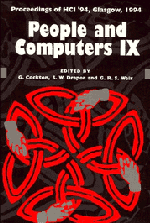Book contents
- Frontmatter
- Contents
- Preface: HCI'94 – You Probably Haven't Seen It All Before
- Part I Invited Papers
- Part II Methodology of Interactive Systems Development
- Crafting Interaction: Styles, Metaphors, Modalities and Agents
- 10 A Comparison of Placement Strategies for Effective Visual Design
- 11 Evaluation of Alternative Operations for Browsing Hypertext
- 12 On the Problem of Selecting Interaction Objects
- 13 Minimising Conceptual Baggage: Making Choices about Metaphor
- 14 Keeping an Eye on your Interface: The Potential for Eye-Based Control of Graphical User Interfaces (GUI's)
- 15 A Linguistic Approach to Sign Language Synthesis
- 16 Generalisation and the Adaptive Interface
- 17 Agent-Based Interaction
- Modelling Humans, Computers and their Interaction
- Notations and Tools for Design
- Part VI Computer-Supported Cooperative Work
- Author Index
- Keyword Index
11 - Evaluation of Alternative Operations for Browsing Hypertext
Published online by Cambridge University Press: 04 August 2010
- Frontmatter
- Contents
- Preface: HCI'94 – You Probably Haven't Seen It All Before
- Part I Invited Papers
- Part II Methodology of Interactive Systems Development
- Crafting Interaction: Styles, Metaphors, Modalities and Agents
- 10 A Comparison of Placement Strategies for Effective Visual Design
- 11 Evaluation of Alternative Operations for Browsing Hypertext
- 12 On the Problem of Selecting Interaction Objects
- 13 Minimising Conceptual Baggage: Making Choices about Metaphor
- 14 Keeping an Eye on your Interface: The Potential for Eye-Based Control of Graphical User Interfaces (GUI's)
- 15 A Linguistic Approach to Sign Language Synthesis
- 16 Generalisation and the Adaptive Interface
- 17 Agent-Based Interaction
- Modelling Humans, Computers and their Interaction
- Notations and Tools for Design
- Part VI Computer-Supported Cooperative Work
- Author Index
- Keyword Index
Summary
The aim of the Previewing Information Operation (PIO) approach is to tackle some overhead factors imposed on the user-hypertext interaction. The purpose is to diminish cognitive overhead and disorientation problems by reducing some of their causes.
This paper describes an experiment carried out to evaluate the usability of the operations based on the PIO approach. Results from between-groups studies show that subjects' evaluation of the ease of use of the system and feeling of general orientation were affected by the presence of PIO operations. A further study has revealed that the PIO operations were predicted by standard navigational operations.
Keywords: hypertext, link selection, previewing information, evaluation.
Introduction
When referring to a user's interaction with a hypertext system, the metaphor generally used in the literature is that the user navigates or browses through the information by selecting those links which are interesting.
In such a scenario, an interactive session could be described as a sequence of link selections along with other navigational operations, as for instance backtracking and string searching. Each of the link selection operations performed is a very important unit of the navigation sequence the user goes through: without the link options and the navigation taking place by the user freely choosing among links, there is no hypertext.
Accordingly, the secondary navigational modes such as bookmarks, history lists, backtracking and search operations (Bernstein & Joyce, 1992), are probably as important as the link selection alternatives. Firstly, they promote the understanding of the embedded hypertext structure and the building of a cognitive map. Secondly, they help users orientate themselves when they are lost.
- Type
- Chapter
- Information
- People and Computers , pp. 145 - 162Publisher: Cambridge University PressPrint publication year: 1994



